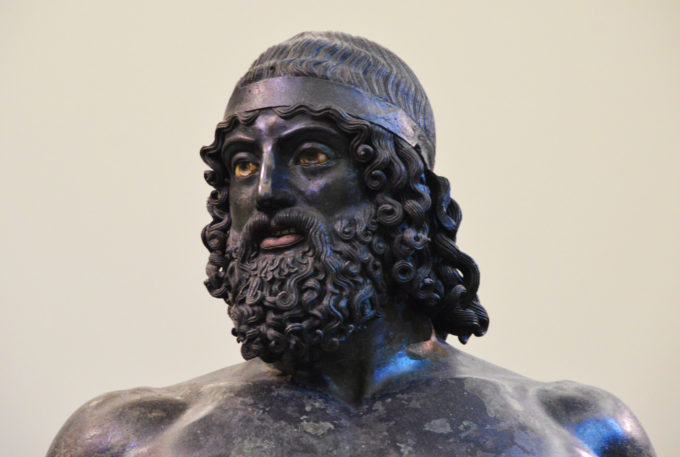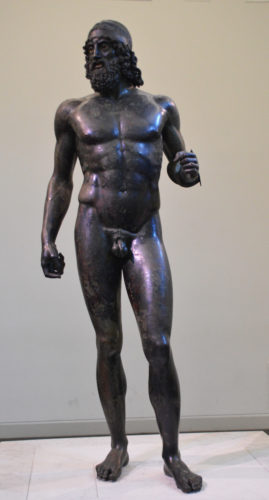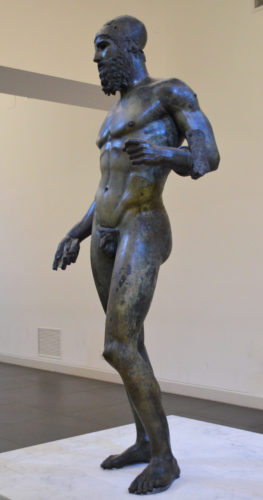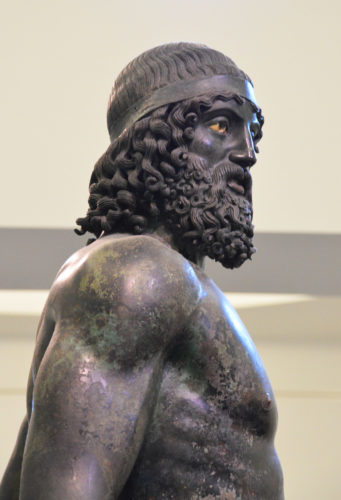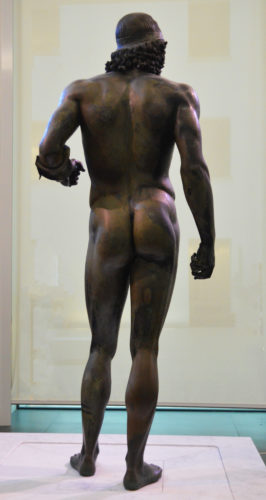Today is the 45th anniversary of the discovery of the Riace Bronze Warriors. I visited this museum with a dear friend who was thoroughly in awe by what she saw and has a great appreciation for the workmanship that went into sculpting bronze statues of this magnitude. As a college student, she was a math major but also took as many sculpture classes as she could fit into her schedule. She fell in love with sculpture and was so very fortunate to have had a foundry at her college. She has worked with bronze and has a very clear understanding of the intricate process behind the making of these statues.
THE RIACE BRONZES
This past May I took an exciting road trip through southern Italy. One of the highlights was a visit to Reggio Calabria (the toe of the boot) to see the Riace Bronzes at Nuovo Museo Archeologico Nazionale. They are truly magnificent! On August 16th, 1972, the Riace Bronzes were discovered on a recreational scuba dive by Stefano Mariottini in the Ionian Sea off the coast of Riace, Italy. It is believed these bronze masterpieces laid at the bottom of the sea for an estimated 2000 years. After about two years of restoration, revealing the marvelous skill and craftsmanship that went into making them, they were beautifully brought back to their former glory. These statues are displayed in a controlled environment at the museum. Every person who enters the viewing room where the statues are displayed must first enter an airlock, where a high-tech cleansing process takes place before entering the room where these great statues are displayed. It’s truly quite an interesting process but once you actually get up close to these well-respected works of art, you’ll appreciate all the precautions.
The Riace Bronzes or Warriors are referred to as Statue A and Statue B; they are 6 1/2 and almost 6 3/4 feet tall, respectively. I was mesmerized by these two breathtakingly impressive Bronzes. It’s amazing to think that these statues were crafted by Greek sculptors 2500 years ago.
Yes, 2500 years ago! It is believed that Statue A was sculpted around 460 to 450 BC and Statue B, between 430 and 420 BC.
What impressed me most, aside from the obvious physical perfection, is the attention to detail of their hair and beards on these statues, especially Statue A.
The time taken to carve each lock of hair shows the dedication that these artists had for their craft. This is an extremely time-consuming task, especially considering it was done so very long ago. It’s absolutely fascinating to see. Their lips and nipples were made of copper, their teeth were made of silver and their eyes were probably made of either ivory or glass and set in pronged settings as in jewelry. Absolutely fascinating!
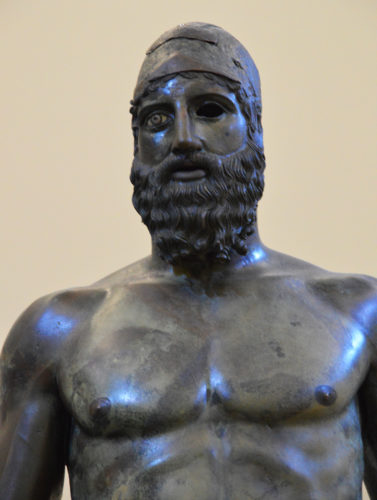
Even though he’s missing one eye, you can see how perfectly the eye socket was crafted to hold the glass eye.
I studied Sculpture in college while pursuing a degree in Mathematics, so I can appreciate the workmanship that it takes to sculpt bronzes of this magnitude. The process we used was called the lost wax process. The students would sculpt a statue in wax first. Then we had to add a “funnel” to the top of the wax piece and add “vents” at all the low points so that when the molten bronze was poured, the air could escape so there weren’t any air pockets or empty spaces in the final product. Already you can see the amount of care and attention to detail that goes into a work of art like this. Then, we would create a mold using plaster of Paris. The plaster molds were baked in a kiln where the wax would evaporate, essentially lost. Then the mold was cast by carefully pouring hot, liquid bronze into the “funnel”, then left to cool completely. At this point, we would chip away at the plaster mold, destroying it, to uncover the bronze statue. The vents and funnel were sawed off and the piece was then sanded and polished to finish. It’s an incredibly labor-intensive process but through it, captivating works of bronze artwork that will last for ages are created.
The process behind that ultimately created the breathtaking lifelike Riace bronzes was a little different but just as much a labor of love. Statues of this magnitude were hollow (like a chocolate Easter bunny) and usually sculpted on a clay-based sculpture with rods added to support the structure. Wax was applied to the base sculpture and the very fine details were carved out. Then, they were carefully covered with another layer of clay or plaster so the detail would be retained. The wax had to be melted away (lost) and then replaced with molten bronze in the area between the two pieces of clay.
The statues had to be made in sections, then put together after the pieces were cast. It is quite a laborious process even with modern technology; I am in awe of the artists who were able to create such magnificent works of bronze art and am thankful that they have passed along their techniques and knowledge. I am so grateful to have had the opportunity to visit the Warriors!
I highly suggest visiting the Museo Archeologico Nazionale di Reggio Calabria even if just to see the Riace Bronzes. If you are a sculptor and/or have ever worked with bronze, you definitely won’t want to miss this opportunity to get up close to such ancient life-like bronze artwork with enormous attention to details. That is where the beauty has lived on for centuries.
To learn more about the Riace Bronzes, please click here.
